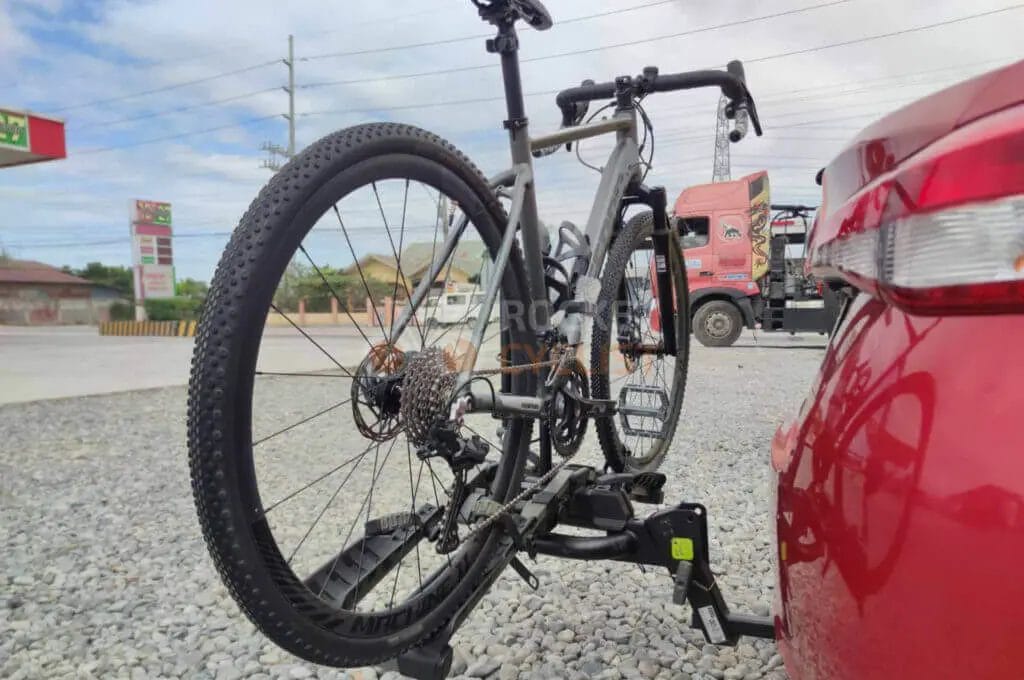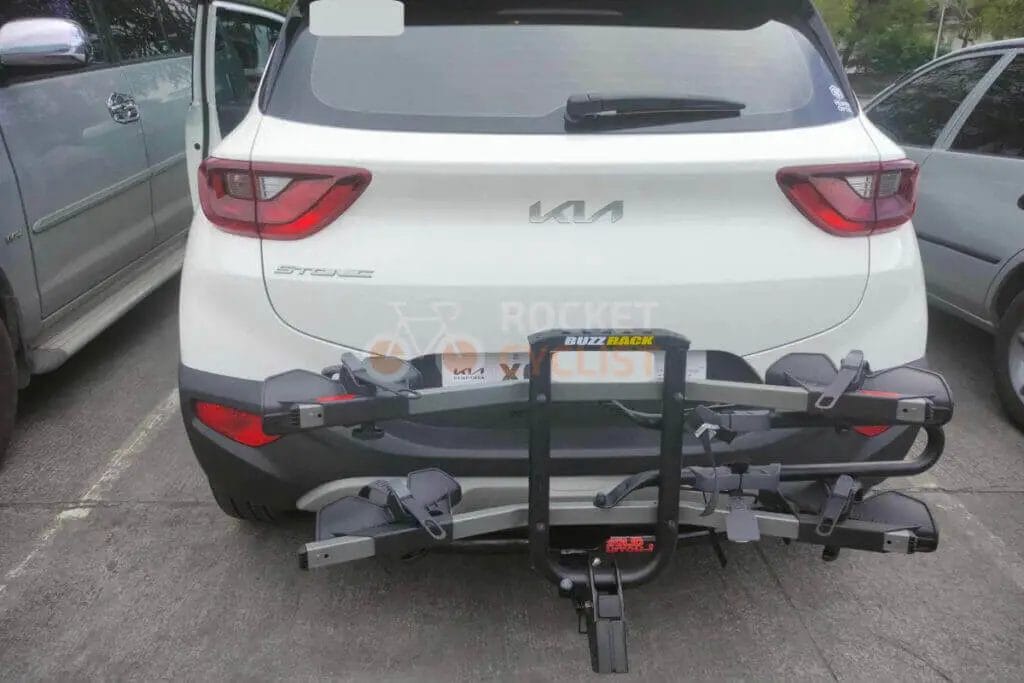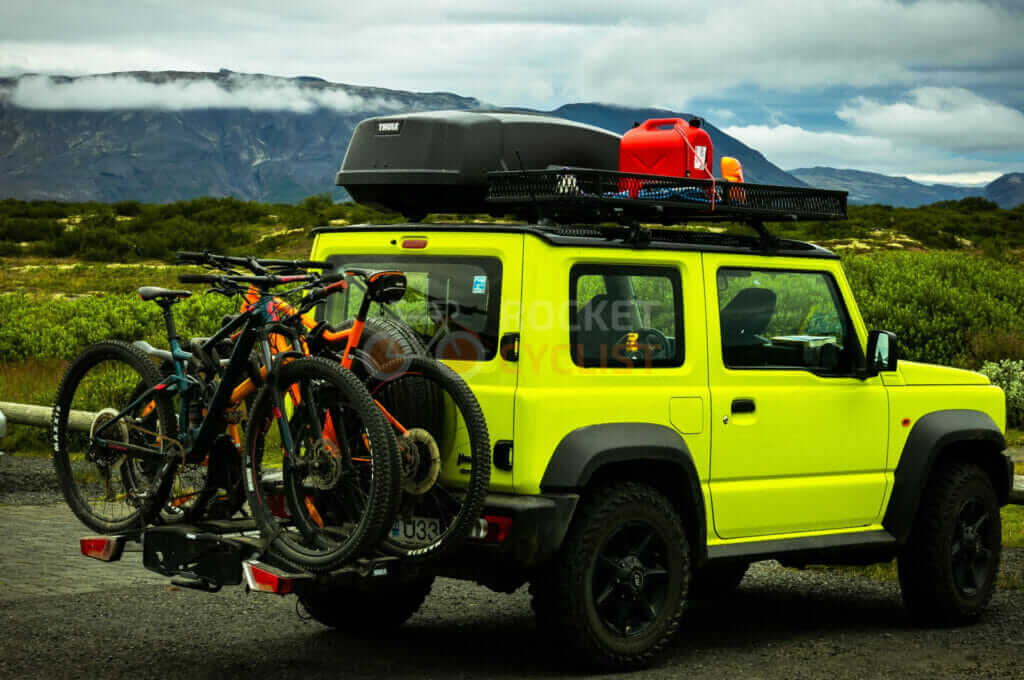Last Updated on February 11, 2024 by Vinson Lozano

As a bike enthusiast, you know that the safety of your two-wheeled companion is of utmost importance. Whether you’re heading out on a thrilling mountain biking adventure or going on a leisurely ride through the city, the last thing you want is for your bike to be stolen or damaged while on a hitch rack. In this article, we will address the common risks and concerns associated with bike security on hitch racks, provide tips on choosing the right rack, offer advice on properly securing your bikes, discuss additional security measures, and outline best practices for hitch rack maintenance. By the end of this guide, you’ll be equipped with the knowledge and tips needed to lock and load your bikes with confidence. So let’s jump in and ensure your bike’s security on hitch racks!
Why bike security on hitch racks is important
Ensuring bike security on hitch racks is important for several reasons. Firstly, bikes can be valuable and expensive investments, so protecting them from theft and damage is crucial. Secondly, when bikes are not properly secured on hitch racks, they can become loose or fall off during transit, posing a safety hazard to other motorists on the road. Additionally, stolen bikes can lead to frustration, inconvenience, and financial loss for the bike owner. By prioritizing bike security on hitch racks, you can have peace of mind knowing that your bikes are secure and protected during transport. So, whether you’re going on a short trip or a long-distance adventure, taking the necessary steps to secure your bike on a hitch rack is essential for a worry-free ride.
Common risks and concerns
When it comes to bike security on hitch racks, there are common risks and concerns that every cyclist should be aware of. One major concern is the risk of theft. Leaving your bike unattended on a hitch rack makes it vulnerable to opportunistic thieves. Another concern is the potential for damage during transport. Bikes can shift, sway, or even fall off if not properly secured, leading to scratches, dents, or even complete destruction of your beloved ride. Additionally, rough road conditions or sudden stops can cause bikes to collide with each other or with the vehicle, resulting in costly repairs. By addressing these risks and implementing proper security measures, you can ensure a stress-free and incident-free journey with your bikes on hitch racks.
Choosing the Right Hitch Rack for Bike Security
To ensure bike security on hitch racks, it’s crucial to choose the right rack that meets your needs. Consider the following factors when selecting a hitch rack:
- Compatibility: Ensure the rack is compatible with your vehicle’s hitch receiver size and weight capacity.
- Stability: Look for racks with sturdy construction and anti-sway features to minimize bike movement during transit.
- Bike capacity: Determine how many bikes you need to transport and choose a rack that can accommodate them all.
- Ease of use: Opt for racks that are easy to install, load, and unload, reducing the risk of accidents or damage.
When choosing a hitch rack, prioritize features like locking mechanisms, adjustable cradles, and secure straps. By selecting the right hitch rack, you can provide a solid foundation for bike security during transportation.
Factors to consider when selecting a hitch rack
When selecting a hitch rack for bike security, there are several factors to consider:
- Compatibility: Ensure the hitch rack is compatible with your vehicle’s hitch receiver size and weight capacity. Check the specifications of both the rack and your vehicle to ensure a proper fit.
- Stability: Look for a hitch rack with sturdy construction and anti-sway features. This will minimize bike movement during transit and prevent any potential damage.
- Bike capacity: Determine how many bikes you need to transport and choose a rack that can accommodate them all. Consider if you’ll need to carry different types of bikes, such as road bikes or mountain bikes, and ensure the rack can handle them.
- Ease of use: Opt for a hitch rack that is easy to install, load, and unload. This will reduce the risk of accidents or damage, making it more convenient for you to use.
By considering these factors, you can select a hitch rack that offers the best bike security for your specific needs.
Hitch rack features that enhance bike security
When selecting a hitch rack for bike security, it’s important to consider the features that enhance the protection of your bikes. Look for features such as:
- Adjustable straps or cradles: These ensure a snug fit for your bikes, reducing the risk of movement or damage during transportation.
- Anti-sway technology: This feature prevents bikes from swaying or colliding with each other, minimizing the potential for scratches or dents.
- Integrated locks: Hitch racks with built-in locks provide an added layer of security by preventing bike theft while your vehicle is unattended.
- Wheel clamps or trays: These features securely hold the bike wheels in place, eliminating any chance of the bikes shifting or falling off during transit.
By choosing a hitch rack with these enhanced security features, you can have peace of mind knowing that your bikes are well-protected during transportation.
Tips for Properly Securing Bikes on Hitch Racks

Properly securing your bikes on a hitch rack is crucial to ensure their safety during transportation. Follow these tips to securely fasten your bikes:
- Position the bikes correctly: Place the heaviest bike closest to the vehicle, with the lighter bikes towards the outer edges. This distribution helps maintain balance and stability.
- Use adjustable straps or cradles: Ensure a secure fit by adjusting the straps or cradles to firmly hold the bikes in place. This reduces the risk of movement or damage.
- Secure the bike frames: Use additional locks or straps to secure the bike frames to the rack. This prevents any accidental release or theft.
- Secure the wheels: Attach wheel clamps or trays to hold the bike wheels securely. This adds another layer of stability and prevents any spinning or shifting during transit.
- Double-check before hitting the road: Before driving, give the bikes a firm shake to ensure they are securely attached. Recheck all straps, locks, and clamps to eliminate any potential risks.
By following these tips, you can have peace of mind knowing that your bikes are properly secured on the hitch rack and ready for a smooth and safe journey.
Proper bike placement and positioning on the rack
When it comes to securing your bikes on a hitch rack, proper placement and positioning are crucial for stability and safety. Follow these tips to ensure your bikes are securely fastened:
- Position the bikes correctly: Place the heaviest bike closest to the vehicle, with the lighter bikes towards the outer edges. This distribution helps maintain balance and stability during transportation.
- Use adjustable straps or cradles: Adjust the straps or cradles on the rack to firmly hold the bikes in place. Make sure they are snug and secure, reducing the risk of movement or damage.
- Secure the bike frames: Use additional locks or straps to secure the bike frames to the rack. This adds an extra layer of stability and prevents accidental release or theft.
- Secure the wheels: Attach wheel clamps or trays to hold the bike wheels securely. This prevents any spinning or shifting during transit.
- Double-check before hitting the road: Before driving, give the bikes a firm shake to ensure they are securely attached. Recheck all straps, locks, and clamps to eliminate any potential risks.
By following these tips, your bikes will be properly positioned and secured on the hitch rack, ensuring a smooth and worry-free journey.
Securing bikes with additional locks and accessories
When it comes to bike security on hitch racks, using additional locks and accessories can provide an extra layer of protection. Consider the following options to keep your bikes safe on the rack:
- Cable locks: Invest in a sturdy cable lock to secure your bikes to the hitch rack. Thread the cable through the bike frames and around the rack, making it harder for thieves to quickly snatch your bikes.
- U-locks: U-locks are known for their high level of security. Attach a U-lock around the bike frame and secure it to a solid part of the rack, such as the hitch receiver. This makes it difficult for thieves to remove the bikes from the rack.
- Wheel locks: Ensure the wheels are secured by using wheel locks or skewers. These accessories lock the wheels in place, preventing them from being easily detached or tampered with.
Remember, these additional locks and accessories are meant to deter potential thieves and make it more challenging for them to steal your bikes. However, it’s essential to be aware that determined thieves may still find ways to bypass these measures.
Additional Security Measures

When it comes to protecting your bikes on hitch racks, there are additional security measures you can take to increase their safety. Hitch locks are a great option to prevent thieves from removing the entire rack from your vehicle. These locks attach to the hitch receiver and secure the rack in place, making it difficult to detach.
In addition, using cable locks can provide extra protection for your bikes. Thread the cable through the bike frames and around the rack, creating an extra layer of security. This makes it more challenging for potential thieves to quickly snatch your bikes.
When storing your bikes overnight or traveling long distances, consider using a tarp or cover to conceal them from prying eyes. This simple measure can deter theft and keep your bikes out of sight.
By utilizing these additional security measures, you can have peace of mind knowing that your bikes are well-protected on your hitch rack.
Using hitch locks and cable locks for added protection
When it comes to protecting your bikes on hitch racks, using hitch locks and cable locks can provide added security and peace of mind. Hitch locks are a simple yet effective way to prevent thieves from removing the entire rack from your vehicle. These locks attach to the hitch receiver and securely hold the rack in place, making it difficult for anyone to detach it without the key.
Additionally, using cable locks can further enhance the security of your bikes. You can thread the cable through the bike frames and around the rack, creating an extra layer of protection. This makes it much more challenging for potential thieves to quickly snatch your bikes and ride off.
By using hitch locks and cable locks in combination, you significantly decrease the risk of bike theft while transporting your bikes on hitch racks.
Security tips for overnight storage and long-distance travel
When it comes to overnight storage or long-distance travel with your bikes on a hitch rack, there are a few additional security tips to keep in mind. Here are some recommendations to ensure the safety of your bikes:
- Choose secure parking: When parking overnight, opt for well-lit areas or places with security cameras. Look for designated bike parking areas or consider using a bike lockup facility if available.
- Use additional locks: In addition to hitch locks and cable locks, consider using a secondary lock specifically designed for overnight storage. These locks provide extra peace of mind and deter potential thieves.
- Check on your bikes regularly: If you’re staying at a hotel or campground, periodically check on your bikes to ensure they’re secure and haven’t been tampered with.
- Be cautious during rest stops: When making pit stops during long-distance travel, keep an eye on your bikes and don’t leave them unattended for an extended period of time.
By following these security tips, you can enjoy your overnight stays or long-distance journeys with the confidence that your bikes are well-protected on your hitch rack.
Best Practices for Hitch Rack Maintenance
To ensure your hitch rack remains in top condition and continues to provide reliable bike security, it’s important to follow some best practices for maintenance. Here are a few tips to keep in mind:
- Regular inspection and maintenance: Regularly inspect the hitch rack for any signs of wear or damage. Check the straps, bolts, and joints for tightness and make any necessary adjustments or repairs.
- Cleaning: Keep your hitch rack clean by regularly removing dirt, debris, and salt residue. Use a mild detergent and water to clean the rack and ensure all moving parts are free from grime.
- Lubrication: Apply a silicone lubricant or bike-specific lubricant to moving parts, such as pivot points and folding mechanisms, to keep them functioning smoothly.
- Proper storage: When not in use, store your hitch rack in a dry and secure location to protect it from the elements and potential theft.
By following these maintenance practices, you can prolong the lifespan of your hitch rack and ensure it continues to provide secure transportation for your bikes.
Regular inspection and maintenance of the hitch rack
Regular inspection and maintenance of your hitch rack is essential to ensure bike security and optimal performance. By regularly checking your hitch rack, you can identify any signs of wear or damage before they escalate into bigger issues. Here are some key steps to include in your maintenance routine:
- Inspect the straps, bolts, and joints for any signs of looseness or damage. Tighten any loose parts and replace any damaged components.
- Check the hitch connection to ensure it is securely fastened to your vehicle.
- Clean and lubricate any moving parts to prevent rust and ensure smooth operation.
- Inspect the bike cradles and tie-down straps for any signs of wear or fraying. Replace any worn-out or damaged parts to ensure secure bike attachment.
By following these regular maintenance practices, you can extend the lifespan of your hitch rack and enjoy worry-free bike transportation.
Cleaning and lubrication for optimal performance
To ensure optimal performance and longevity of your hitch rack, it is crucial to include regular cleaning and lubrication in your maintenance routine. Here are some key steps to follow:
- Cleaning: Remove any dirt, debris, or grime from the rack using a mild detergent and a soft brush or cloth. Pay special attention to the moving parts and cradles where the bikes are secured.
- Lubrication: Apply lubricant to all moving parts, such as hinges and joints, to minimize friction and ensure smooth operation. Use a bike-specific lubricant or a spray lubricant that is compatible with metal and plastic surfaces.
- Protect against rust: After cleaning and lubricating, consider applying a rust-resistant spray to metal parts to prevent corrosion.
By regularly cleaning and lubricating your hitch rack, you can optimize its performance, prevent damage, and ensure a secure and hassle-free bike transportation experience.
Conclusion
In conclusion, ensuring bike security on hitch racks is of utmost importance to protect your valuable bikes from theft and damage. By choosing the right hitch rack with secure features, proper placement and positioning of bikes, and using additional locks and accessories, you can greatly enhance bike security during transport. It is also essential to take additional security measures such as using hitch locks and cable locks, and following security tips for overnight storage and long-distance travel. Regular maintenance and cleaning, including lubrication, are crucial for optimal performance of your hitch rack. By following these best practices, you can have peace of mind knowing that your bikes are securely stored and protected on your hitch rack.
Importance of ensuring bike security on hitch racks
Ensuring bike security on hitch racks is of utmost importance to protect your valuable bikes from theft and damage. Hitch racks provide a convenient way to transport bikes, but without proper security measures, your bikes can be at risk. By choosing the right hitch rack with secure features, such as locking mechanisms and anti-sway cradles, you can greatly reduce the chances of your bikes getting stolen or damaged during transport. Additionally, securing your bikes properly on the rack with additional locks and accessories adds an extra layer of security. Taking these precautions will give you peace of mind knowing that your bikes are safe and secure while on the road. Don’t compromise on bike security, invest in the necessary measures to protect your precious bikes.
Final thoughts and recommendations
When it comes to ensuring bike security on hitch racks, there are a few final thoughts and recommendations to keep in mind. First and foremost, always choose a hitch rack that is specifically designed to securely transport bikes. Look for features such as locking mechanisms, anti-sway cradles, and adjustable straps to ensure a tight and stable fit. Additionally, don’t forget to properly position and secure your bikes on the rack, using additional locks and accessories for added security. When storing your bikes overnight or traveling long distances, consider using hitch locks and cable locks to further protect your bikes from theft. Finally, regular inspection and maintenance of the hitch rack, including cleaning and lubrication, will ensure optimal performance and longevity. By following these recommendations, you can have peace of mind knowing that your bikes are safe and secure during transport.


